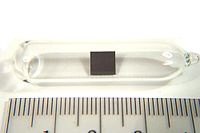
Photo from wikipedia
Abstract The Wadi Al-Baroud area is located close to the tectonic boundary between the Northern and Central Eastern Desert of Egypt. The exposed rocks include younger (post-tectonic) and older (syn-tectonic)… Click to show full abstract
Abstract The Wadi Al-Baroud area is located close to the tectonic boundary between the Northern and Central Eastern Desert of Egypt. The exposed rocks include younger (post-tectonic) and older (syn-tectonic) granitoids and rare metal pegmatites (plugs and dikes). The rare metal pegmatites are comprised of feldspar, quartz, and mica, and occur chiefly within the barren younger granites and at their contact with the older granitoids. Strategic rare metal mineralization related to pegmatites includes mangano- to ferro-columbite, zircon, monazite-(Ce), yttrocolumbite, thorite, U-thorite, xenotime, euxenite-(Y), samarskite-(Y), and fergusonite-(Y) minerals that are frequently associated with mica and iron oxides. In this study, the zircon, monazite, and thorite are used as potential monitors of the internal evolution of pegmatite and evolution of the granite-pegmatite system. In the younger A-type granite, zircon and thorite are common and form a solid solution with xenotime. In the pegmatite body, thorite forms a solid solution with coffinite, while zircon is Hf-rich pegmatitic type and forms two phases in the same grain - one is highly enriched in non-formula (Ca, Fe, Al, and Mn) and incompatible (Th, U, and Y) elements and the other is a chemically near-end member. In the pegmatite dike, zircon has the highest Hf and near-end-member stoichiometric compositions, while thorite is Y-rich uranothorite. Furthermore, monazite is a primary magmatic phase in the younger granites, but in pegmatite is sulfur-rich REE altered phase. Textural and chemical results show that these phases formed sequentially and intermittently through multi-genetic processes during the evolution from the granite to rare metal pegmatite and define two main chemical trends: 1) a continuous fractionation from the melt to pure exsolving hydrothermal fluid, and 2) a dissolution-recrystallization during fluid-saturated late-magmatic stages. Zircon displays a continuous Zr/Hf fractionation trend, indicating evolution from a silicate melt to an aqueous fluid. Besides, all pegmatite zircons form a solid solution with xenotime and this is a chemical fingerprint inherited from the granite zircon. Together, these suggest that the pegmatite was formed from a hydrous aluminosilicate melt and that high field strength elements (such as Nb, Y, Zr, U, and Th) can be mobilized during the magmatic to hydrothermal evolution of the alkaline granite-pegmatite system. Even in ore-barren granitic rocks, the high charge-to-ionic-radius ratios of these elements and generally incompatible nature during magmatic fractionation facilitate their extreme enrichment, even to ore-forming levels. Zircon, monazite, and thorite can provide effective exploration tools for identifying and characterizing rare metal-bearing pegmatites and insights into the mineralizing processes.
Journal Title: Ore Geology Reviews
Year Published: 2021
Link to full text (if available)
Share on Social Media: Sign Up to like & get
recommendations!